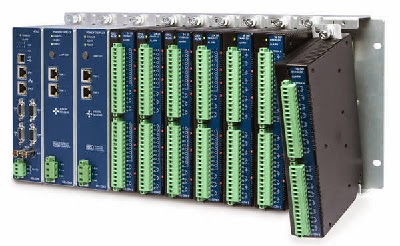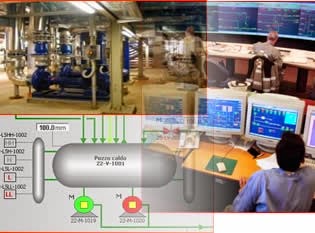Difference between PLC and DCS
The Programmable Logic Controller (PLC) is king of machine control while the Distributed Control System (DCS) dominates process control. If you manufacture plastic widgets, you speak PLC. If you produce chemicals, you speak DCS.
Today, the two technologies share kingdoms as the functional lines between them continue to blur. We now use each where the other used to rule. However, PLCs still dominate high-speed machine control, and DCSs prevail in complex continuous processes.
Distributed Control System:
The early DCS looked dramatically different from the early PLC. Initially, the DCS performed the control functions of the analog panel instruments it replaced, and its interface mimicked their panel displays. DCSs then gained sequence logic capabilities to control batch processes as well as continuous ones. DCSs performed hundreds of analog measurements and controlled dozens of analog outputs, using multi-variable Proportional Integral Derivative (PID) control. With the same 8-bit microprocessor technology that gave rise to the DCS, PLCs began replacing conventional relay/solid-state logic in machine control. PLCs dealt with contact input/output (I/O) and started/stopped motors by performing Boolean logic calculations.
The big change in DCS over the past 20 years is its move from proprietary hardware to the personal computer (PC) and standard LAN technologies. With each advance in PC power, DCSs have moved up in power. PCs gave us speedy, responsive, multi-media, windowed, operator-process interfaces (OPI). Relational databases and spreadsheet software enhance the ability of DCSs to store and manipulate data. Artificial intelligence (AI) technology gives us “smart” alarming. Today’s DCS architecturally looks much like the DCS of 20 years ago, but tomorrow’s DCS may control through networked “smart” devices-with no I/O hardware of its own.
Most DCSs offer redundant controllers, networks, and I/Os. Most give you “built-in” redundancy and diagnostic features, with no need for user-written logic.
DCSs allow centralized configuration from the operator or engineering console in the control room. You can change programming offline, and download without restarting the system for the change to be effective.
DCSs allow inter-controller communications. You can do data exchange in most DCS systems ad hoc (no need for predefined data point lists). You access data by tag name, regardless of hardware or location.DCSs use multi-tasking operating systems, so you can download and run applications aside from the real-time control functions and still do fractional-second control. DCSs now come in “micro” systems, to price-compete with PLCs-but with full DCS features and capabilities.

The typical DCS has integrated diagnostics and standard display templates that automatically extend/update when your database changes. This database is central to the system-you don’t have different databases sitting in the controllers.
DCSs have user-friendly configuration tools, including structured English, control block libraries, SFC (sequential function chart), and even RLL (relay ladder logic).
Most DCSs allow graphical configuration, provide online diagnostics, and are self-documenting. Most provide for user-defined control blocks or customized strategies. The controllers execute control strategies as independent tasks; thus, making changes to part of the control logic has no impact on the rest.
An important difference between DCSs and PLCs is how vendors market them. DCS vendors typically sell a complete, working, integrated, and tested system; offering full application implementation. They offer many services: training, installation, field service, and integration with your Information Technology (IT) systems. A DCS vendor provides a server with a relational database, a LAN with PCs for office automation, networking support and integration of third-party applications and systems. The DCS vendor tries to be your “one-stop shop.”
Programmable Logic Controller:
The PLC is more of a “do-it-yourself” device, which is sometimes simpler to execute.

Programmable Logic Controllers. When PLCs were solely replacements for hard-wired relays, they had only digital I/O, with no operator interface or communications. Simple operator interfaces appeared, then evolved into increasingly complex interfaces as PLCs worked with increasingly complex automation problems. We went from a panel of buttons and I/O-driven lamps to PLC full-color customized graphic displays that run on SCADA software over a network.
PLCs now have many DCS-like control functions (e.g., PID algorithms) and analog I/O. They’ve moved past their birthplace: the digital world (switch and binary sensor inputs and output contacts to run motors and trigger solenoids).
PLCs are fast: They run an input-compute-output cycle in milliseconds. On the other hand, DCSs offer fractional second (1/2 to 1/10) control cycles. However, some DCSs provide interrupt/event-triggered logic for high-speed applications.
PLCs are simple, rugged computers with minimal peripherals and simple OSs. While increasing reliability, PLC simplicity is not conducive to redundancy. Thus, fully redundant (“hot,” automatic, bumpless) variations of PLCs, with their added hardware and software, sometimes suffer from a reduction in their reliability-a characteristic PLCs are famous for.
Data exchange typically requires you to preassign data registers and hard code their addresses into the logic. If you add registers or need to reassign data, you typically have to deal manually with the Domino Effect.
Typical PLC Relay Ladder Logic (RLL) languages include function blocks that can perform complex control and math functions (e.g., PID algorithms). Complex multi-loop control functions (e.g., cascade management and loop initialization) are not typical. For functions too messy to implement in RLL, most PLCs provide a function block that calls a user-written program (usually in BASIC or C).
PLCs typically operate as “state” machines: They read all inputs, execute through the logic, and then drive the outputs. The user-written logic is typically one big RLL program, which means you may have to take the whole PLC off-line to make a change of any size. You also run into database synchronization problems because of the separation of PLCs and the Man Machine Interface (MMI) software packages, as opposed to the central databases of DCSs.
A PLC will run in a stand-alone configuration. A DCS controller normally expects an operator interface and communications, so it can send alarms, messages, trend updates, and display updates.Many PLC installations use interface software from third-party vendors for improved graphics and various levels of alarming, trending, and reporting. The PLC and MMI software normally interact by sitting on the network and using the register exchange mechanism to get data from and to the various PLCs. This type of communication presumes you have preassigned data registers and can fetch data on an absolute address basis. This can lead to data processing errors (e.g., from the wrong input) you won’t encounter with the central database of a DCS.
Some PLCs use proprietary networks, and others can use LANs. Either way, the communication functions are the same-fetch and put registers. This can result in bottlenecking and timing problems if too many PCs try communicating with too many PLCs over a network.
A PLC may have a third-party package for operator interfaces, LAN interface to PCs and peripherals, PLC data highway or bus, redundant controllers with local and distributed I/O, local MMI and local programming capability. The PLC would have redundant media support, but not the redundant communication hardware or I/O bus hardware you’d find in a DCS. A PLC would have preprogrammed I/O cards for specific signal types and ranges.
Today, the decision between PLC and DCS often depends on business issues rather than technical features. Questions to consider are those involving:
The internal expertise to execute the project, Level of support available from a vendor/integrator, Long-term maintainability, and Life-cycle costs.
PLCs and DCSs overlap in their features, but also have distinct strengths and weaknesses. When deciding between the two, know who will deliver and support your system, and how they will do it.

